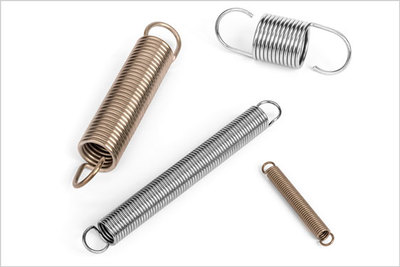
Contact Details:
Lee Spring Ltd
Latimer Road
Wokingham
Berkshire
RG41 2WA
United Kingdom
Tel: +44 (0)118 9781800
Fax: +44 (0)118 9774832
Send Enquiry | Company Information

Lee Spring puts the Tension in Extension Springs
Product News Thursday, May 7, 2020: Lee Spring Ltd
Lee Spring extension springs – otherwise known as tension springs – are indispensable to many operations in vehicle applications and elsewhere e.g. as returns on engine controls, also farm machinery, horse boxes, caravans, trampolines, garage doors, medical devices, toys, washing machines/white goods, and in the construction industry. They are characterised by a loop or hook on either end which is connected to other components giving them extra strength and manoeuvrability.
An extension spring works by absorbing and storing energy in its coils so that when the two components attached at either end are pulled apart, thus extending the spring, it resists and exerts a similar amount of force. The reason extension springs are commonly used in cars is that many automobile parts use electrical solenoids or hydraulics to power movement one direction only, which later relies on the mechanical retraction force from an extension spring for full cycle.
The extension spring comes in many shapes and sizes, including customised models which are popular with classic car enthusiasts looking for the perfect part. Several types of connector can be specified including full loop, double twisted loop and hook, and Lee Spring’s extension springs can be ordered in a wide range of materials, including corrosion-resistant types which are especially important for vehicles that will be used exposed to the rain.
Extension springs absorb and store energy as well as create a resistance to a pulling force. It is their initial tension that determines how tightly together an extension spring is coiled. This initial tension can be manipulated to achieve the load requirements of a particular application. Extension Springs are wound to oppose extension - they are often tightly wound in the no-load position and have hooks, eyes, or other interface geometry at the ends to attach to the components they connect. They are frequently used to provide return force to components that extend in the actuated position.
Extension springs come in a wide array of sizes, from small medical devices to off-road machinery brake springs and are supplied with full diameter loops (either machine or crossover centre) at a random position. Loop openings are approximately one wire diameter and the direction of wind is optional. Lee Stock Extension Springs are available in both Imperial and Metric designs.
Other Lee Spring Extension spring ends include threaded inserts, extended twist loops, crossover center loops, hooks, expanded eyes, reduced eyes, rectangular ends and teardrop-shaped ends, which can all be produced to vary in distance from the spring body. At the design stage of a Custom Extension Spring, the length of the hooks at each end of the spring can be adjusted in order to precisely obtain the required spring load at any extended position.
Another common type of extension spring is the drawbar spring. In a drawbar, the load is applied at the ends of long steel loops which pass through the spring's centre and are hooked around the opposite end, thus compressing the spring upon loading. Drawbar springs are excellent for use in potential overload situations and offer a built-in defined stop that will continue to carry a static load after reaching the maximum extended length.
Further information on Extension Springs from Lee Spring can be found at www.leespring.co.uk/uk_int_learn_extension.asp .
